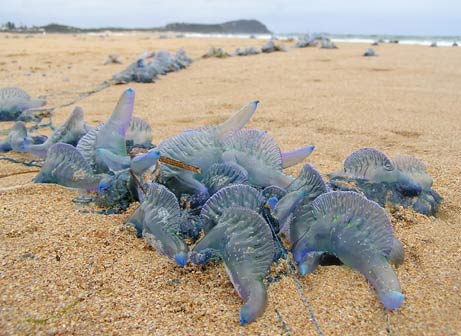Bluebottle jellyfish, Physalia utriculus
Also known as the Portuguese Man O' War.
It is not a true jellyfish.
It appears that jellyfish numbers are increasing in various oceans of the world. This includes a recent increase in giant Nomura's jellyfish in Japan, rafts of jellyfish that swamped Mediterranean shores last summer and now, record numbers of bluebottle jellies on the beaches of Australia -- all of which suggest that their growing numbers are due to warming ocean waters as well as overfishing.
"[Their] numbers are closely tied with environmental changes, and last year was obviously a very aggressive year for them," Lisa-Ann Gershwin, a jellyfish expert with SLS.
More than 30,000 people were stung by the translucent blue jellies on this coast last year--more than twice the number of incidents in 2005--according to Australia's lifeguard group, Surf Life Saving (SLS).
And in a single weekend earlier this month, beachgoers reported more than 1,200 stings, several requiring hospitalization.
The blue bottle is more widely known as the Portuguese Man O' War because it is said to resemble a Portuguese battleship in full sail. The bluebottle jellyfish is not a true jellyfish because it has a float instead of a bell that it actively contracts to move through the water. Unlike true jellyfishes, this jellyfish is not a single organism, but made up of a number of different organisms, known as zooids. Each zooid has a specific role, such as being part of a stinging tentacle or the float, and together they all function as if it were a single animal. Blue bottle jellyfish can range in color from blue to pinkish color, and they have a transluscent body. The float or body of the blue bottle measures between 3 to 15 centimeters and the tentacles range in length from 15 centimeters up to 10 meters.
"Jellyfish have been around for 600 million years," Gershwin said. "They have perfected the art of survival and are very good at taking advantage of changing conditions."
Cited story.
.
- Log in to post comments


They are weirdly beautiful creatures.
It's another reminder that survival patterns of species during global warming may be like that of invasive species; most die out or fare poorly, but a few are much more prosperous than in their original environment.
So far, it's pine beetles, bedbugs, poison ivy, poison oak, kudzu, and stinging jellyfish.
I was stung on my feet by these guys once. The pain started out relatively mild then grew steadily more intense as it traveled up my legs and into my groin. The sensation was very odd, seeming almost to come from the inside out. It was accompanied by a sort of visceral distress like nausea, but not nausea, along with a sense of urgent anxiety. Not utterly horrible like a scorpion's sting (been there too), but very definitely unpleasant.
Here via COTS (Such a striking photo, how could I not click through?) - is this not the most beautiful wrack line ever?
I was stung by one of these when I was eight years old and still have 11 different scares are my stomach and arms. The sting is very unpleasant and very painful for someone at that age
Seeing as that the planet has been cooling since 1998, where is the Global Warming⢠coming from? Just asking.
The insistence of maintaining the AGW theory as an excuse for all that can't be conveniently explained by our limited knowledge of natural systems at some time must start to deal with reality.